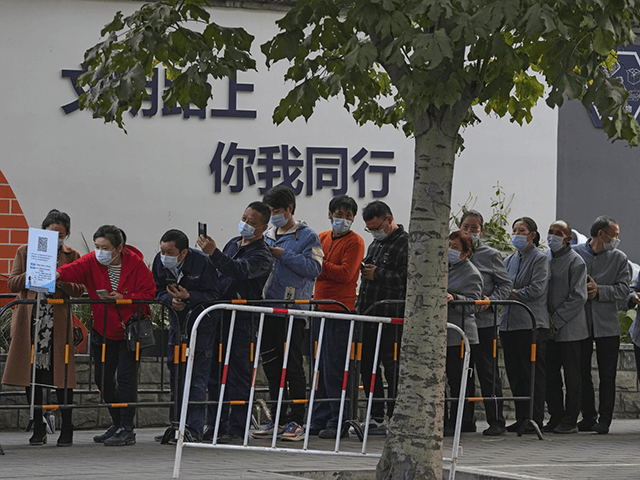China is currently battling a nationwide resurgence of its coronavirus caseload, with new infections detected in “more than half of its provinces and municipalities” in recent days, the state-run Global Times reported Tuesday.
“At least 18 Chinese provinces and municipalities, with Southwest China’s Chongqing Municipality and Chengdu in Sichuan the latest, reported confirmed COVID-19 [Chinese coronavirus] cases as of Tuesday [November 2],” according to the newspaper. “The capital Beijing reported four new cases on Monday [November 1], taking the total case number to 35.”
China’s northeastern city of Heihe, located along the country’s border with Russia in Heilongjiang province, recorded 26 new coronavirus infections on November 2. The caseload spike prompted municipal authorities to declare one Heihe residential community a “high-risk area” and 14 others “medium-risk areas.” City officials completely sealed off “51 residential communities where COVID-19 [Chinese coronavirus] cases were found,” the Global Times reported. The Heihe Center of Disease Prevention and Control has enforced “closed-circle management mode” within the 51 locked down communities, “where life necessities are delivered and psychological consultations are provided.”
China has officially documented 500 new coronavirus infections since its latest epidemic of the disease sparked on October 17. Chinese Communist Party (CCP) authorities say they traced the mid-October outbreak to a tour group that originated in eastern China’s Shanghai city and traveled to the Inner Mongolia Autonomous region in early October. Members of the tour group allegedly contracted coronavirus from a foreign source — likely from Mongolia — and subsequently spread the disease throughout China during and after the tour, according to Beijing’s account. The Communist Party has offered no evidence linking the tour group any foreign source in Mongolia or elsewhere at press time.
“Experts are still looking into what caused the outbreak in Ejina Banner, a county in North China’s Inner Mongolia Autonomous Region, which they believe was caused by imported cases,” the Global Times, an official CCP newspaper, wrote on November 2.
“The origin of the Heihe outbreak also remains unknown, and it is not related to the recent flare-ups in Inner Mongolia and Gansu Province,” the publication revealed. Gansu Province neighbors the Inner Mongolia Autonomous Region.
Beijing, China’s national capital, canceled half of all flights into and out of the metropolis on November 2 in an effort to contain the country’s ongoing coronavirus epidemic. Local CCP officials also locked down Tiantongyuan — Beijing’s most densely populated neighborhood, home to 142,700 residents — on Tuesday after allegedly detecting just four new coronavirus infections in the community. Tiantongyuan is “an enormous neighborhood in Beijing’s Changping district reputed to be the largest residential area in Asia,” according to the Global Times. Beijing health authorities detected 30 new cases of the Chinese coronavirus in Changping district on November 2.
